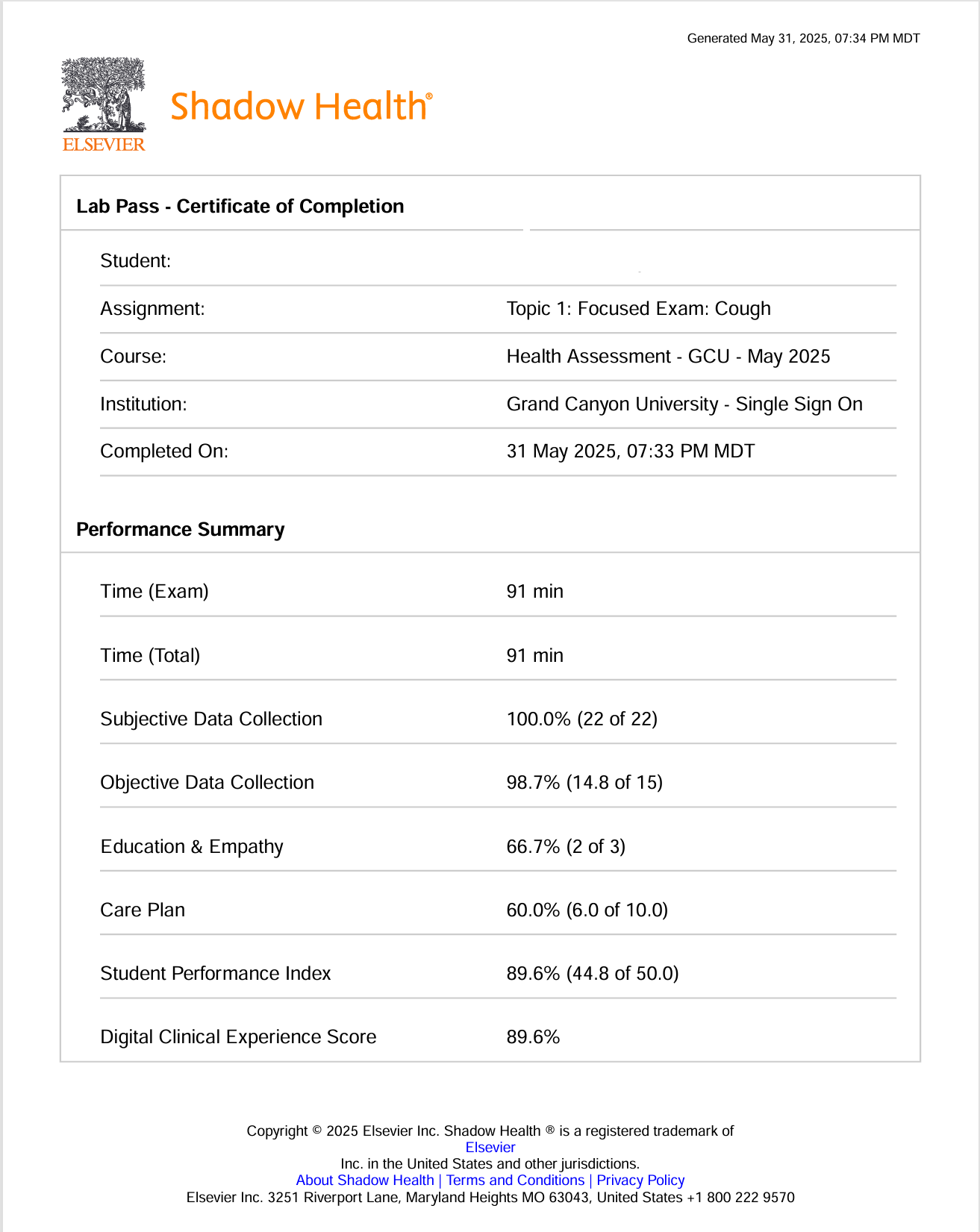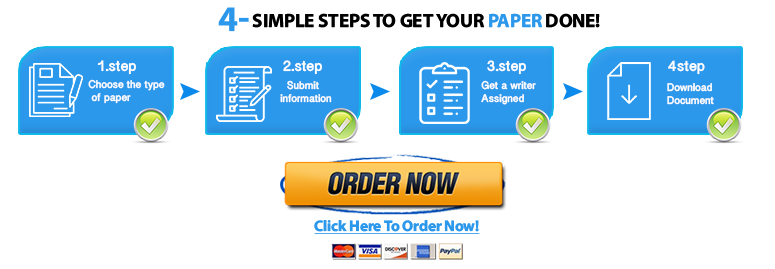Last updated on August 27th, 2025 at 11:51 am
Table of Contents
ToggleIn this assignment you will be conducting a focused exam on a patient presenting with cough. Interview the patient, assess the related body systems, and then complete post-exam activities
Shadow Health: Focused Exam: Cough Results
In this assignment you will be conducting a focused exam on a patient presenting with cough. Interview the patient, assess the related body systems, and then complete post-exam activities. Within the Shadow Health platform, complete the Focused Exam: Cough Results. The estimated average time to complete this assignment each time is 1 hour and 15 minutes. Please note, this is an average time. Some students may need additional time.
You can attempt this assignment as many times as you would like. After completing this focused exam, you will be awarded a Digital Clinical Experience (DCE) score. The DCE score will appear on your Lab Pass which you will submit to the classroom drop box. The DCE score will be used as your percentage grade for this assignment.
You are not required to submit this assignment to LopesWrite.
American Association of Colleges of Nursing Core Competencies for Professional Nursing Education
This assignment aligns to AACN Core Competency 2.8.
Expert Guide and Explanation

Place your order now for a similar assignment and get fast, affordable and best quality work written by our expert level assignment writers. Use Coupon: NEW30 to Get 30% OFF Your First Order
Use Coupon: NEW30 to Get 30% OFF Your First Order

Evidence-Based Clinical Cough Assessment: A Comprehensive Guide for Healthcare Professionals
Cough is one of the most prevalent symptoms encountered in clinical practice, accounting for over 26 million office visits in the United States annually and representing the most common complaint for which patients seek medical attention. With a weighted prevalence of 5.0% for chronic cough in the United States, healthcare professionals must possess comprehensive assessment skills to effectively evaluate and manage patients presenting with this symptom.
This evidence-based guide provides healthcare practitioners with current best practices for conducting thorough cough assessments, incorporating the latest clinical guidelines and research findings to ensure optimal patient care and diagnostic accuracy.
Understanding Cough: Clinical Definitions and Classifications
Acute vs. Chronic Cough Classification
The clinical classification of cough is fundamental to proper assessment and management:
| Cough Type | Duration | Key Characteristics | Primary Considerations |
|---|---|---|---|
| Acute Cough | < 3 weeks | Often viral etiology | Self-limiting, symptomatic care |
| Subacute Cough | 3-8 weeks | Post-infectious or transitional | May require investigation |
| Chronic Cough | > 8 weeks (adults) | Persistent, complex etiology | Requires comprehensive evaluation |
| Chronic Cough (Pediatric) | > 4 weeks | Different threshold in children | Age-specific considerations |
Current Medical Guidelines
Recent updates to international guidelines emphasize the importance of systematic assessment approaches. Assessment of children and adults requires a focused history of chronic cough to identify any red flag cough pointers that may indicate an underlying disease, according to the Australian CICADA guidelines published in 2024.
The European Respiratory Society guidelines highlight that the concept of cough hypersensitivity has allowed an umbrella term that explains the exquisite sensitivity of patients to external stimuli such a cold air, perfumes, smoke and bleach.
Comprehensive Patient Interview Techniques
Essential History Components
A systematic approach to cough history collection includes:
1. Temporal Characteristics
- Onset and duration
- Pattern throughout the day
- Seasonal variations
- Relationship to sleep and activities
2. Cough Quality and Characteristics
- Dry vs. productive
- Sound characteristics
- Associated symptoms
- Triggers and alleviating factors
3. Associated Symptoms Assessment
- Dyspnea or shortness of breath
- Chest pain or discomfort
- Fever or systemic symptoms
- Weight loss or night sweats
- Gastroesophageal reflux symptoms
Red Flag Symptoms Requiring Immediate Attention
Healthcare professionals must remain vigilant for warning signs that indicate serious underlying pathology:
| Red Flag Symptom | Clinical Significance | Immediate Action Required |
|---|---|---|
| Hemoptysis | Possible malignancy or infection | Urgent referral/imaging |
| Significant weight loss | Malignancy concern | Comprehensive workup |
| Progressive dyspnea | Cardiopulmonary disease | Cardiac/pulmonary evaluation |
| Fever > 38.5°C | Infectious process | Antimicrobial consideration |
| Chest pain | Multiple etiologies | ECG, imaging as indicated |
Physical Examination Protocols
Respiratory System Assessment
A systematic physical examination should include:
1. General Inspection
- Overall appearance and distress level
- Use of accessory muscles
- Positioning preferences
- Cyanosis or pallor
2. Chest Examination
- Inspection for deformities or asymmetry
- Palpation for tenderness or masses
- Percussion for dullness or hyperresonance
- Auscultation with focus on:
- Breath sound quality
- Adventitious sounds (crackles, wheezes, rhonchi)
- Vocal fremitus changes
3. Additional System Examinations
- Cardiovascular assessment for heart failure signs
- Head and neck examination for upper airway pathology
- Abdominal examination for hepatomegaly or ascites
Diagnostic Testing Considerations
Further assessment with examination should include a chest x‐ray and spirometry (when age > 6 years) according to current Australian guidelines.
Evidence-Based Assessment Tools
Validated Cough Assessment Scales
Several validated tools assist in quantifying cough severity and impact:
Leicester Cough Questionnaire (LCQ)
- 19-item validated instrument
- Assesses physical, psychological, and social domains
- Useful for monitoring treatment response
Cough-Specific Quality of Life Questionnaire (CQLQ)
- 28-item questionnaire
- Evaluates impact on daily activities
- Reliable outcome measure for research
Objective Cough Monitoring
Modern technology enables objective cough assessment through:
- 24-hour cough monitors
- Smartphone-based applications
- Acoustic analysis systems
Current Epidemiology and Statistics
Global Prevalence Data
Recent epidemiological studies reveal important patterns in cough presentation:
- Chronic cough affects 5.0% of the US population, with respondents being older and more predominantly female
- Chronic cough accounts for more than one-third of outpatient visits to respiratory clinics in China
- Complete recovery from acute cough occurs in 40.2-67% of patients after two weeks, and 79% after four weeks
Recent Public Health Trends
The healthcare landscape has seen significant changes in cough-related presentations:
- In 2024, reported cases of pertussis increased across the United States, with more than six times as many cases reported compared to 2023
- Cases have risen in several countries, including Brazil, Mexico, Peru, and the United States, likely due to declined vaccination coverage during COVID-19
Expert Insights on Clinical Assessment
Leading respiratory medicine experts emphasize the paradigm shift in understanding chronic cough. “Chronic cough remains a significant clinical challenge, affecting approximately 10% of the population and leading to significant impairment in psychological, social, and physical quality of life,” according to recent research published in The Journal of Allergy and Clinical Immunology: In Practice (Source).
Dr. Alyn Morice, a leading expert in cough research, and colleagues advocate for a revolutionary approach: “Chronic cough should be considered a disease. The condition has distinct characteristics and is more than a symptom of other disorders. Approaching chronic cough as a disease should sharpen focus, increase understanding and improve patient outcomes,” as published in the European Respiratory Society journal (Source).
The New England Journal of Medicine highlights the complexity of assessment, noting that “Chronic cough is now understood to be a condition of neural dysregulation” when it proves intractable to standard treatment (Source).
Recent consensus among specialists emphasizes that “Panelists reached a consensus on statements about chronic cough diagnosis, helping to solidify opinions that can assist in the future creation of assessment guidelines” (Source).
Technology Integration in Cough Assessment
Digital Health Tools
Modern cough assessment increasingly incorporates digital technologies:
Smartphone Applications
- Cough counting algorithms
- Symptom tracking capabilities
- Patient-reported outcome measures
Wearable Devices
- Continuous monitoring capabilities
- Activity correlation analysis
- Sleep pattern assessment
Artificial Intelligence Applications
- Pattern recognition in cough sounds
- Predictive modeling for diagnosis
- Treatment response prediction
Quality Assurance and Best Practices
Documentation Standards
Comprehensive documentation should include:
- Structured History Recording
- Temporal patterns
- Associated symptoms
- Previous treatments
- Response to interventions
- Physical Examination Findings
- Systematic approach documentation
- Objective measurements
- Comparative assessments
- Assessment and Planning
- Differential diagnosis considerations
- Diagnostic test rationale
- Treatment planning rationale
Continuous Professional Development
Healthcare professionals should maintain current knowledge through:
- Regular guideline review
- Professional society membership
- Continuing medical education
- Peer consultation networks
Future Directions in Cough Assessment
Emerging Research Areas
Current research focuses on:
- Biomarker identification for cough subtypes
- Personalized medicine approaches
- Novel therapeutic targets
- Improved diagnostic algorithms
Precision Medicine Applications
Future cough assessment may incorporate:
- Genetic testing for cough susceptibility
- Microbiome analysis
- Metabolomic profiling
- Artificial intelligence-guided diagnosis
Conclusion
Effective cough assessment requires a systematic, evidence-based approach incorporating current medical guidelines and best practices. Healthcare professionals must remain updated on evolving diagnostic criteria, utilize validated assessment tools, and maintain awareness of epidemiological trends affecting patient populations.
The integration of traditional clinical skills with modern technology offers opportunities for improved diagnostic accuracy and patient outcomes. As our understanding of cough pathophysiology continues to evolve, practitioners must adapt their assessment techniques to incorporate new evidence and maintain the highest standards of patient care.
By following the comprehensive assessment framework outlined in this guide, healthcare professionals can provide optimal evaluation and management for patients presenting with cough, ultimately improving patient outcomes and satisfaction while reducing healthcare resource utilization.
References and Additional Resources
- Morice, A.H., et al. (2024). “Chronic cough as a disease.” European Respiratory Society. Available here
- The Journal of Allergy and Clinical Immunology: In Practice. (2024). “The Clinical Approach to Chronic Cough.” Available here
- New England Journal of Medicine. (2024). “Unexplained or Refractory Chronic Cough in Adults.” Available here
- American Journal of Managed Care. (2023). “Specialists Reach a Consensus on Chronic Cough Assessment and Diagnosis.” Available here
- Australian Government Department of Health – CICADA Guidelines: Medical Journal of Australia
- British Thoracic Society Clinical Statement on Chronic Cough: Thorax Journal Guidelines
- European Respiratory Society Guidelines: ERS Journal Publications
- American College of Chest Physicians Guidelines: CHEST Guidelines
- Agency for Healthcare Research and Quality: Effective Health Care Program
- Centers for Disease Control and Prevention: Pertussis Surveillance
- Cleveland Clinic. (2023). “Chronic Cough: Causes & Treatment.” Available here
- StatPearls – NCBI Bookshelf. (2024). “Chronic Cough.” Available here

